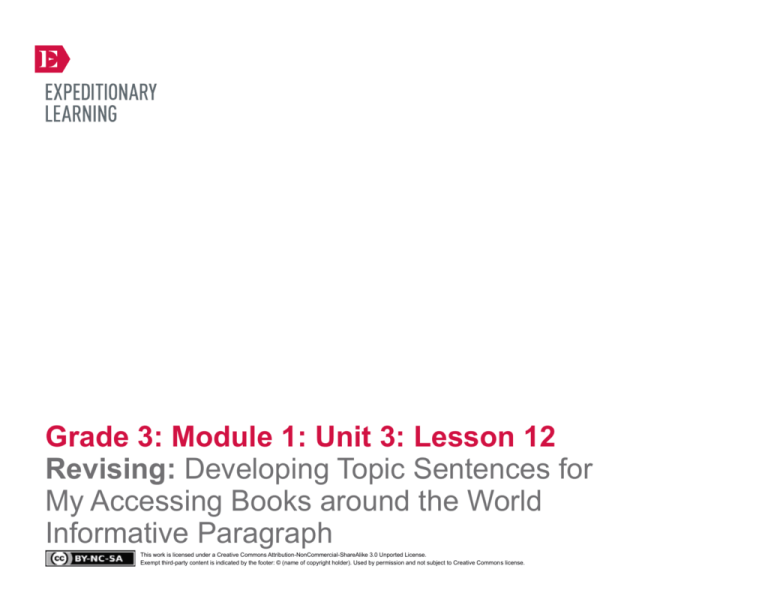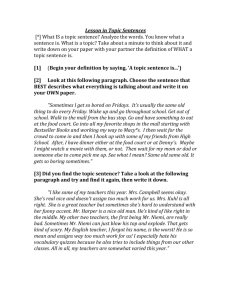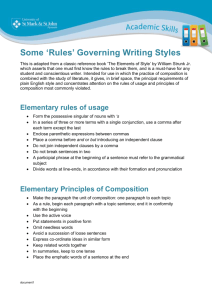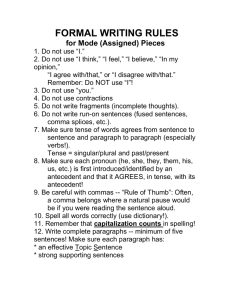
Grade 3: Module 1: Unit 3: Lesson 12
Revising: Developing Topic Sentences for
My Accessing Books around the World
Informative Paragraph
This work is licensed under a Creative Commons Attribution-NonCommercial-ShareAlike 3.0 Unported License.
Exempt third-party content is indicated by the footer: © (name of copyright holder). Used by permission and not subject to Creative Commons license.
GRADE 3: MODULE 1: UNIT 3: LESSON 12
Revising: Developing Topic Sentences for My
Accessing Books around the World Informative Paragraph
Long-Term Targets Addressed (Based on NYSP12 ELA CCLS)
I can use the writing process to plan, revise, and edit my writing (with support). (W.3.5)
I can write an informative text. (W.3.2)
Supporting Learning Targets
Ongoing Assessment
• I can revise my Accessing Books around the World informative paragraph to include a topic sentence
that captivates my reader.
• Revisions of students’ topic sentence and details
• I can revise my Accessing Books around the World paragraph to include important details about how
my librarian or organization is special.
Agenda
Teaching Notes
1. Opening
• Use strong models of topic sentences and detail for Work Time Parts A and B. A paragraph model is
provided; adapt as necessary.
A. Unpacking the Learning Targets (5 minutes)
2. Work Time
A. Revision Lesson A: Topic Sentences (10 minutes)
• A model Accessing Books around the World Paragraph Content Checklist is provided in the supporting
materials. Use this as a guide and adapt as necessary to suit the needs of your students.
B. Student Revision of Topic Sentences (10 minutes)
C. Revision Lesson B: Important Details (10 minutes)
D. Student Revision of Details (20 minutes)
3. Closing and Assessment
A. Debrief (5 minutes)
4. Homework
A. None.
Copyright © 2013 by Expeditionary Learning, New York, NY. All Rights Reserved.
NYS Common Core ELA Curriculum • G3:M1:U3:L12 • March 2014 •
1
GRADE 3: MODULE 1: UNIT 3: LESSON 12
Revising: Developing Topic Sentences for My
Accessing Books around the World Informative Paragraph
Lesson Vocabulary
Materials
include, introduce, details, complete
sentence, paragraph, topic sentence,
revise
• Model Paragraph: That Book Woman (from Lesson 11)
• Student paragraph drafts (collected at the end of Lesson 11)
• Chart paper
• Markers
• Accessing Books around the World Paragraph Content Checklist (for Teacher Reference)
Opening
Meeting Students’ Needs
A. Revision Lesson A: Topic Sentences (10 minutes)
• Display the model paragraph: That Book Woman and highlight/underline the topic sentence. Read aloud the topic
sentence a few times and ask students to Think-Pair-Share what they notice about a clear topic sentence. Solicit a few
responses from the class and guide students toward these general criteria and create an anchor chart for future reference:
“What makes a clear topic sentence for an Accessing Books around the World paragraph?” Responses might include: “The
writer uses a complete sentence,” and “The writer tells the reader specifically who/what the paragraph is about.”
• Use thoughtful grouping: ELL
language acquisition is facilitated by
interacting with native speakers of
English who provide models of
language.
Work Time
Meeting Students’ Needs
A. Identifying Criteria for a Quality Paragraph (15 minutes)
• Give students a model paragraph: That Book Woman, ideally a teacher-generated one about a librarian/organization
that students will not have the option of writing about. Consider using the librarian from the teacher model in Lesson 10.
Remind students about the Accordion paragraph structure they learned about in Unit 1 (topic sentence, supporting detail
sentences, conclusion sentence).
• Consider providing nonlinguistic
symbols for the paragraph criteria
on the anchor chart to assist ELLs in
making connections with
vocabulary.
B. Student Revision of Topic Sentences (10 minutes)
• After students have looked at the model topic sentence and identified the criteria, give them time to revise their own topic
sentence from Lesson 11. Confer with students as they write, referring them to the anchor chart and model topic sentence.
• Collaboration supports students’
engagement.
• Toward the end of this first chunk of Work Time, invite students to read their topic sentence to a peer.
Copyright © 2013 by Expeditionary Learning, New York, NY. All Rights Reserved.
NYS Common Core ELA Curriculum • G3:M1:U3:L12 • March 2014 •
2
GRADE 3: MODULE 1: UNIT 3: LESSON 12
Revising: Developing Topic Sentences for My
Accessing Books around the World Informative Paragraph
Meeting Students’ Needs
Work Time (continued)
C. Revision Lesson B: Important Details (10 Minutes)
• Display the model paragraph again and highlight/underline the detail sentences. Read them aloud a few times and ask
students to Think-Pair-Share what they notice about the detail sentences. Solicit a few responses from the class and guide
students toward these general criteria and create an anchor chart for future reference: “What are important details we need
to include in our Accessing Books around the World Paragraph? Responses might include: “Where the
librarian/organization is located,” “How the person/organization acted special,” and “What they need to do in order to get
books to children.”
• Help students notice that the details are written in complete sentences and the writer uses vivid and precise words to
describe the librarian or organization (point these out in the paragraph).
• Model how to look back at the text and notes that were taken about That Book Woman (Unit 1, Lessons 9 and 10) to verify
important details.
D. Student Revision of Details (20 minutes)
• After students have looked at the model details and identified the criteria, give them time to revise their own details from the
previous lesson. Confer with students as they write, referring them to the anchor chart and model topic sentence as
necessary.
• ELLs should be allotted extended
time to finish the writing task if
needed. ELLs are provided extended
time on NY State assessments.
• Note that time is built in during the following lesson for students to continue to revise their topic sentences and details.
Copyright © 2013 by Expeditionary Learning, New York, NY. All Rights Reserved.
NYS Common Core ELA Curriculum • G3:M1:U3:L12 • March 2014 •
3
GRADE 3: MODULE 1: UNIT 3: LESSON 12
Revising: Developing Topic Sentences for My
Accessing Books around the World Informative Paragraph
Closing and Assessment
Meeting Students’ Needs
A. Debrief (10 minutes)
• Students Pair-Share one or two detail sentences using the sentence frame: “One of my important details is ___________.”
• Consider providing a sentence
frame or starter, or a cloze sentence
to assist ELLs with language
production and give the structure
required.
• If time permits, engage the class in a conversation around strategies they used to write their topic sentences and details.
What were their successes and challenges as writers today?
Assessment Note: Review students’ topic sentences and details and complete the Accessing Books around the World
paragraph criteria list for each student to use in the next lesson.
Meeting Students’ Needs
Homework
• None
Note: A week from now, you need to have organized a real audience for the bookmark share. (It may be students within the
class, students in a different class, families, etc.) This sharing may happen within the lesson or during some other time,
depending on the audience.
Copyright © 2013 by Expeditionary Learning, New York, NY. All Rights Reserved.
NYS Common Core ELA Curriculum • G3:M1:U3:L12 • March 2014 •
4
Grade 3: Module 1: Unit 3: Lesson 12
Supporting Materials
This work is licensed under a Creative Commons Attribution-NonCommercial-ShareAlike 3.0 Unported License.
Exempt third-party content is indicated by the footer: © (name of copyright holder). Used by permission and not subject to Creative Commons license.
GRADE 3: MODULE 1: UNIT 3: LESSON 12
Accessing Books around the World Paragraph
Content Checklist (For Teacher Reference)
Learning Target
Not Yet
Almost There
Excellent!
Teacher
Comments
I can write a clear
topic sentence that
introduces the reader
to my special librarian
or organization.
I can include
important details
about my special
librarian or
organization:
1. where the
librarian/organization
is located
2. how the
person/organization
acted in a special way
in order to deliver
books.
I can write a
conclusion that wraps
up the paragraph for
my reader.
Copyright © 2013 by Expeditionary Learning, New York, NY. All Rights Reserved.
NYS Common Core ELA Curriculum • G3:M1:U3:L12 • March 2014 •
6










